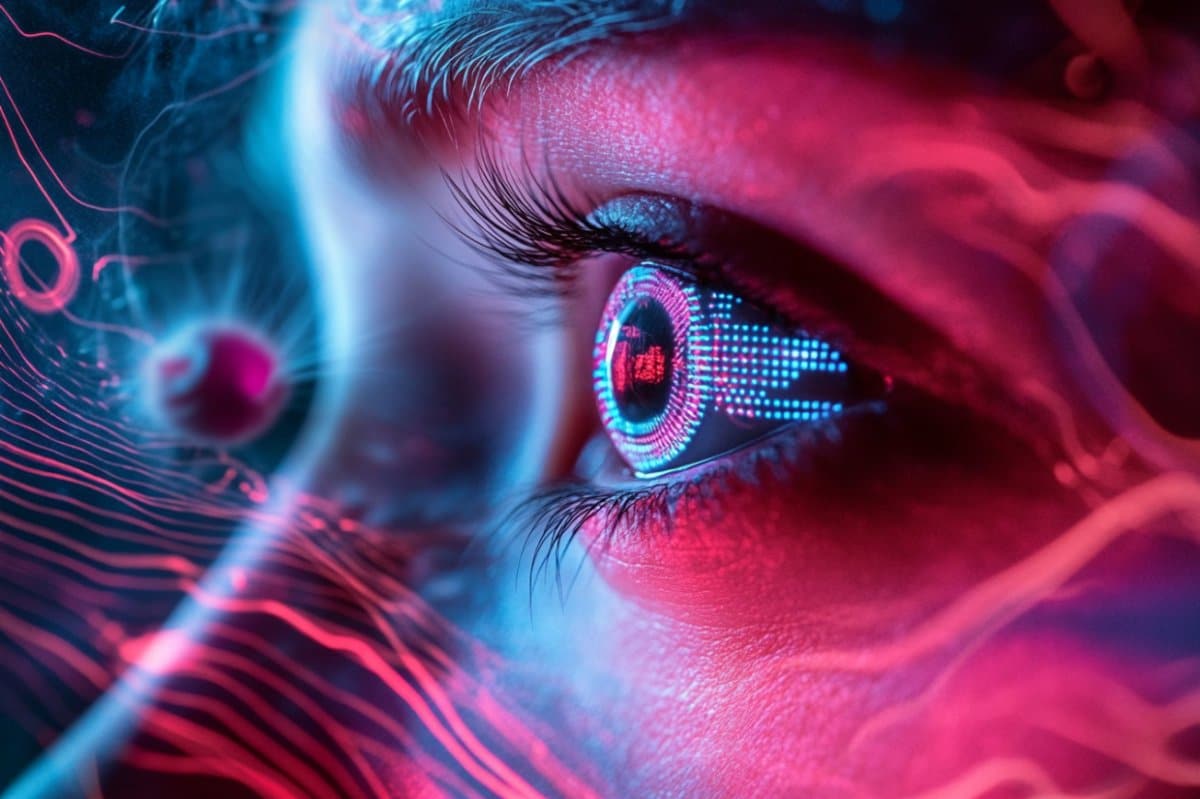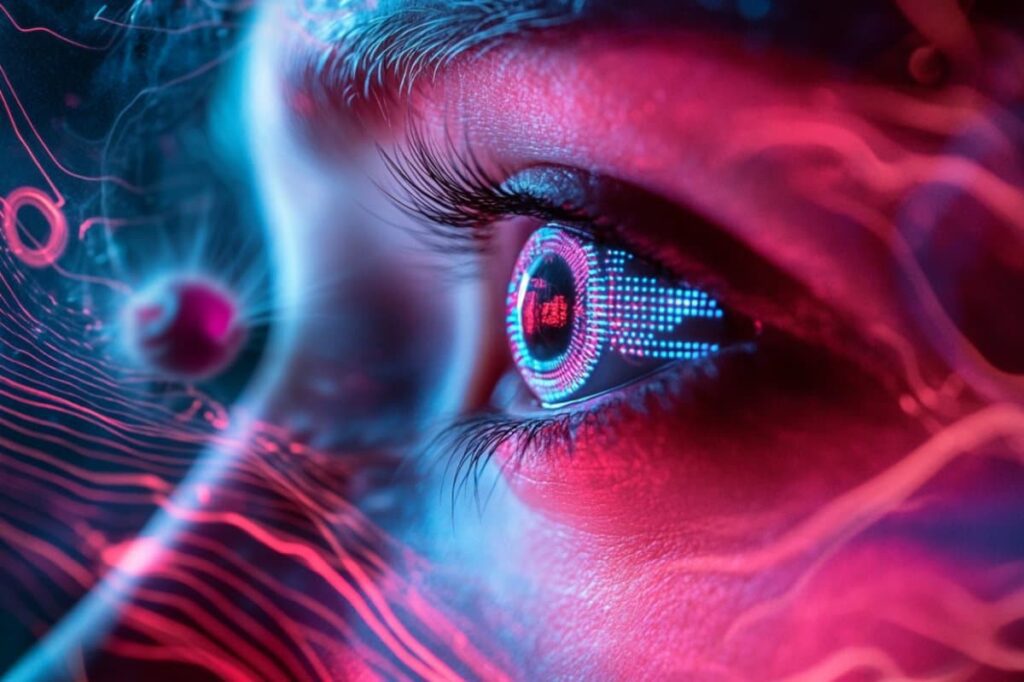Summary: Researchers have developed contact lenses that enable humans and mice to see near-infrared light by converting it into visible wavelengths. These lenses use specialized nanoparticles embedded in standard soft contact material, allowing users to perceive flickering infrared signals without needing external power.
Tests in both animals and humans showed clear behavioral and physiological signs of infrared perception, even with eyes closed. The technology could have wide applications in security, communication, and even color blindness support.
Key Facts:
- Nanoparticle Conversion: Lenses use nanoparticles to convert near-infrared light (800–1600 nm) into visible light.
- Behavioral Proof: Mice wearing the lenses avoided infrared-lit areas, showing active perception.
- Color-Coding Potential: Different wavelengths can be translated into visible color codes, aiding the color blind.
Source: Cell Press
Neuroscientists and materials scientists have created contact lenses that enable infrared vision in both humans and mice by converting infrared light into visible light.
Unlike infrared night vision goggles, the contact lenses, described in the journal Cell on May 22, do not require a power source, and they enable the wearer to perceive multiple infrared wavelengths.
Because they’re transparent, users can see both infrared and visible light simultaneously, though infrared vision was enhanced when participants had their eyes closed.

“Our research opens up the potential for non-invasive wearable devices to give people super-vision,” says senior author Tian Xue, a neuroscientist at the University of Science and Technology of China.
“There are many potential applications right away for this material. For example, flickering infrared light could be used to transmit information in security, rescue, encryption or anti-counterfeiting settings.”
The contact lens technology uses nanoparticles that absorb infrared light and convert it into wavelengths that are visible to mammalian eyes (e.g., electromagnetic radiation in the 400-700 nm range).
The nanoparticles specifically enable detection of “near-infrared light,” which is infrared light in the 800-1600 nm range, just beyond what humans can already see.
The team previously showed that these nanoparticles enable infrared vision in mice when injected into the retina, but they wanted to design a less invasive option.
To create the contact lenses, the team combined the nanoparticles with flexible, non-toxic polymers that are used in standard soft contact lenses. After showing that the contact lenses were non-toxic, they tested their function in both humans and mice.
They found that contact lens-wearing mice displayed behaviors suggesting that they could see infrared wavelengths. For example, when the mice were given the choice of a dark box and an infrared-illuminated box, contact-wearing mice chose the dark box whereas contact-less mice showed no preference.
The mice also showed physiological signals of infrared vision: the pupils of contact-wearing mice constricted in the presence of infrared light, and brain imaging revealed that infrared light caused their visual processing centers to light up.
In humans, the infrared contact lenses enabled participants to accurately detect flashing morse code-like signals and to perceive the direction of incoming infrared light.
“It’s totally clear cut: without the contact lenses, the subject cannot see anything, but when they put them on, they can clearly see the flickering of the infrared light,” said Xue.
“We also found that when the subject closes their eyes, they’re even better able to receive this flickering information, because near-infrared light penetrates the eyelid more effectively than visible light, so there is less interference from visible light.”
An additional tweak to the contact lenses allows users to differentiate between different spectra of infrared light by engineering the nanoparticles to color-code different infrared wavelengths. For example, infrared wavelengths of 980 nm were converted to blue light, wavelengths of 808 nm were converted to green light, and wavelengths of 1,532 nm were converted to red light.
In addition to enabling wearers to perceive more detail within the infrared spectrum, these color-coding nanoparticles could be modified to help color blind people see wavelengths that they would otherwise be unable to detect.
“By converting red visible light into something like green visible light, this technology could make the invisible visible for color blind people,” says Xue.
Because the contact lenses have limited ability to capture fine details (due to their close proximity to the retina, which causes the converted light particles to scatter), the team also developed a wearable glass system using the same nanoparticle technology, which enabled participants to perceive higher-resolution infrared information.
Currently, the contact lenses are only able to detect infrared radiation projected from an LED light source, but the researchers are working to increase the nanoparticles’ sensitivity so that they can detect lower levels of infrared light.
“In the future, by working together with materials scientists and optical experts, we hope to make a contact lens with more precise spatial resolution and higher sensitivity,” says Xue.
Funding:
This research was supported by the Science and Technology Innovation 2030 Major Program, the National Key Research and Development Program of China, the Natural Science Foundation, the CAS Project for Young Scientists in Basic Research, the Major Scientific and Technological Program of Anhui Province, the Anhui Provincial Natural Science Foundation, the New Cornerstone Science Foundation the Feng Foundation of Biomedical Research, and the Human Frontier Science Program.
About this neurotech and visual neuroscience research news
Author: Julia Grimmett
Source: Cell Press
Contact: Julia Grimmett – Cell Press
Image: The image is credited to Neuroscience News
Original Research: Open access.
“Near-Infrared Spatiotemporal Color Vision in Humans Enabled by Upconversion Contact Lenses” by Tian Xue et al. Cell
Abstract
Near-Infrared Spatiotemporal Color Vision in Humans Enabled by Upconversion Contact Lenses
Humans cannot perceive infrared light due to the physical thermodynamic properties of photon-detecting opsins.
However, the capability to detect invisible multispectral infrared light with the naked eye is highly desirable.
Here, we report wearable near-infrared (NIR) upconversion contact lenses (UCLs) with suitable optical properties, hydrophilicity, flexibility, and biocompatibility.
Mice with UCLs could recognize NIR temporal and spatial information and make behavioral decisions.
Furthermore, human participants wearing UCLs could discriminate NIR information, including temporal coding and spatial images.
Notably, we have developed trichromatic UCLs (tUCLs), allowing humans to distinguish multiple spectra of NIR light, which can function as three primary colors, thereby achieving human NIR spatiotemporal color vision.
Our research opens up the potential of wearable polymeric materials for non-invasive NIR vision, assisting humans in perceiving and transmitting temporal, spatial, and color dimensions of NIR light.

